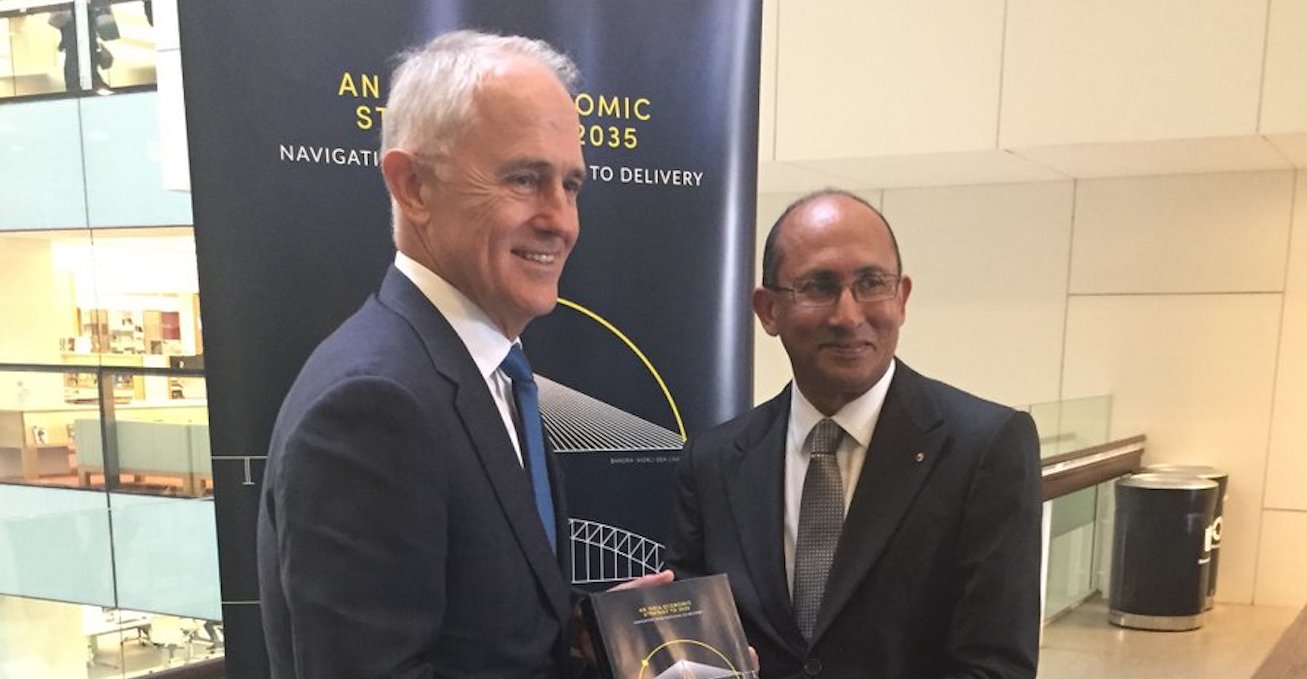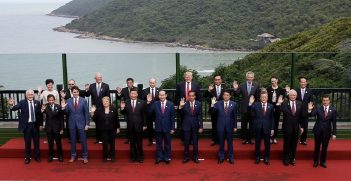Australia Poised for Enhanced Partnership with India

An independent report on an India Economic Strategy to 2035 commissioned by Prime Minister Malcolm Turnbull was released last week. The report provides a roadmap for Australia to engage India as a top priority economic partner over the next two decades.
Last week, the independent report “An India Economic Strategy to 2035: Navigating from Potential to Delivery” was released. It was authored by Peter Varghese AO FAIIA, Chancellor of the University of Queensland and former Secretary of the Department of Foreign Affairs and Trade and former High Commissioner to India. The report, commissioned by Prime Minister Malcolm Turnbull, is the roadmap for Australia to engage India as a top priority economic partner over the next two decades.
This strategy justifies the engagement of India as the fastest growing major economy, set to become the most populous nation, and the third largest economy by 2035. It prioritises the economic and trade opportunities in India by linking Australian business to create a blueprint for India’s economic growth to 2035, matching Australian strengths to Indian priorities.
It recommends that Australia change the perception of India as “too hard” a business destination, citing three reasons: “scale, complementary economies and spreading the risk”. Advocating for a more focused approach from the Australian government and a deeper understanding of India’s business environment, the report calls for an “unambiguous commitment” by Australian business and “deeper understanding” by both business and government of the changing Indian marketplace.
Recommending that a different approach to the relationship with India is needed, the report recommends Australia elevate India into its top-three export markets, make it the third largest Asian destination for outward investment and bring it into the inner circle of Australia’s strategic partnerships.
No doubt India’s massive scale alone encourages ambition. On top of that the complementariness and synergies between the two economies further enhance the scope for Australia-India economic collaboration. The underpinning factors for enhanced Australia-India ties are just not just based on economic convergence but include growing people-to-people interaction, common political values, commonwealth legacy and converging strategic and security interest in the Indo-Pacific.
Education
The report is to the point in recommending education as the ‘flagship sector’. Education can be justified as a top priority sector owing to Australian expertise in the field, the scale of India’s education deficit and the way in which the demand for education and training weaves its way through virtually every sector of the Indian economy.
India’s higher education lacks quality. Indian universities have struggled to compete in global university rankings. This deficit in quality also extends to vocational training and technical colleges. This presents formidable challenges in skilling India’s 400 million young people. In recent years, the Indian government has addressed this issue through international collaboration. Australia has become the second top education destination for Indian students and the Government of India has also taken steps to engage Australian institutions in its education and training programs. In recent years, the education sector has been the main export of Australia to India.
The role of the Indian diaspora
The report highlights the role that Indian-Australians can play in engaging India. At almost 700,000 strong, Australia’s Indian diaspora, comprising both Australians of Indian origin and Indians resident in Australia, is contributing to Australia’s society and economy. After British Australians, the Indian-Australians form the second highest number of taxpaying migrants. At 3 per cent of the Australian population, Indians are the fastest growing diaspora, and Indian-born Australians are expected to outnumber Chinese-born Australians by 2031, reaching 1.4 million.
The role of Indian-Americans in facilitating the US-India relations is exemplary. They have actively lobbied and played a significant role in the US-India ties, touted as the defining partnership of the 21st century. Indian-Americans’ role is acknowledged in creating a positive perception of India for American policy makers.
Despite shared values and the Commonwealth legacy, India–Australia economic relations are yet to reach anywhere near its potential. One of the major hurdles could be the perception of doing business in India. The unease in doing business in India could be ameliorated by engaging Indian diaspora in Australia for an enhanced economic engagement.
The energy market
India’s emergence as a new market for energy and resources means that this component of Australia-India economic relations is set to deepen. The resources and energy sector has been identified as a priority area in the report. Agribusiness may take some time as the difficulties encountered in progressing Australia-India Comprehensive Economic Cooperation Agreement (CECA) because of the lack of appetite by the Indian agriculture sector to meet Australian demands for concessions on tariffs.
But it is the energy market which still has much to deliver for Australia. Despite the push to enhance domestic exploration and production of natural gas and oil, a shift to renewable energy and boost in domestic coal production, India cannot fulfil its mounting energy demand without international collaboration. Australia can complement India’s energy demand mainly by exporting coal, uranium and gas along with innovative technology and practices in the mining and renewable sectors.
India continues to rely heavily on coal for its energy needs. There is a big gap between demand and supply in coal. India’s coal sector is beset with major inefficiencies, productivity stagnation and obsolete technology. According to the International Energy Agency, coal will continue to make the largest contribution to electricity generation in India through to 2040. Despite India’s progress on domestic production of coal, Australia’s thermal coal will continue to be a significant export for India’s energy market due to its less pollutant qualities.
Uranium is another Australian export to India’s lucrative energy market. With the Australia-India civilian nuclear deal, the road for the sale of enriched uranium has been cleared.
Geopolitical considerations
The 2017 Australian Foreign Policy White Paper predicts considerable strategic space for India in the coming decades. In recent years, Australian and Indian security interests have converged on a number of security challenges: stopping the spread of Islamist fundamentalism, defeating international terrorism, securing Afghanistan, stabilising Pakistan as a civilian-dominant secular democracy, preventing the domination of Asia by China and preventing nuclear proliferation to other states and terrorists. But the most important converging security interest lies in the emerging strategic geometry in the Indo-Pacific region.
Amidst the rise of an assertive China and US ambiguity on historical security commitments, concerned nations have been developing various units of Indo-Pacific strategy. Australia and India in recent years pushed towards enhanced security ties. Prime Minister Modi’s latest visit to Indonesia culminated in an India-Indonesia Strategic Partnership. A strategic triangle comprising Australia, India and Indonesia are recent units along with the ongoing US, India and Japan trilateral defence exercise in the Indo-Pacific strategy.
The re-emergence of the Quad comprising the US, India, Japan and Australia, converging Australia-India security interests and India becoming closer to the US-led Political West augur well for all-encompassing Australia-India ties and Indo-Pacific strategy. The Indian Economic Strategy and Foreign Policy White Paper complement the emerging trends in the Indo-Pacific strategy where the maritime democracies converge on protecting the global commons, an open free trade, free navigation, the rules-based international order and preventing domination of the region by a single country.
To ensure that the Australian economy continues its uninterrupted annual economic growth, and businesses continue to thrive and create employment opportunities, Australia must continue to seek out new markets and opportunities. This very timely and well-researched report is a significant contribution and will provide the framework for a long-term relationship between the two countries. It is also a must-read for anyone interested in Australia’s economic future, its geopolitical positioning and the fascinating transformation that is taking place in India.
Dr Ashok Sharma is an Adjunct Associate Professor at the National Asian Studies Centre of Institute for Governance & Policy Analysis at the University of Canberra and an Adjunct Faculty at University of New South Wales Canberra at the Australian Defence Force Academy. He is also deputy chair of the New Zealand Institute of International Affairs, Auckland.
This article is published under a Creative Commons Licence and may be republished with permission.





